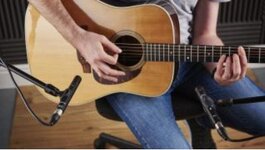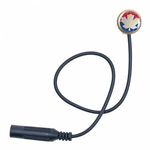Dusty Ol' Bones
Full of green dust
So I wasn't sure if this question should be in the Recording Acoustic Guitar thread. In that thread the consensus seems to be aiming two mikes at the soundhole from different directions. Of course there is nothing wrong with this technique, but it is not the only way. I wish to position one mic at an angle pointing from the outside toward the bridge, so sort of in the general direction of the soundhole but aimed directly at the bridge. The other mic is positioned likewise pointing from the headstock end toward the 12th fret, once again in the direction of the soundhole but aimed directly at fret 12. Below is a screensnip of a stock magazine pic from google image search that demonstrates what I am talking about.

Now that mic placement is out of the way, I actually do have a question. I already own a Shure SM81 SDC that has done very well as a stand alone for recording acoustic guitar. Now that I want to begin recording my instrument with two mikes, I would like to know if y'all have recommendations of which second SDC I should invest in. I want a pair of SDCs but it doesn't matter to me if they are a matched pair. The SM81 was a little pricey for my budget when I bought it 14-15 years ago and even moreso now. Spending no more than $200, hopefully less, what do you think would make a nice complement to the SM81 while not sacrificing too much quality?
When I speak of quality, I don't want something that is cheaply made and will fall apart in 6 months. Something that sounds good and will last a while but may be a little underrated due to smaller name recognition or lesser known reputation. I don't even care if it's another lower priced Shure. Am I being too cheap or does such a thing exist?
Thanks!

Now that mic placement is out of the way, I actually do have a question. I already own a Shure SM81 SDC that has done very well as a stand alone for recording acoustic guitar. Now that I want to begin recording my instrument with two mikes, I would like to know if y'all have recommendations of which second SDC I should invest in. I want a pair of SDCs but it doesn't matter to me if they are a matched pair. The SM81 was a little pricey for my budget when I bought it 14-15 years ago and even moreso now. Spending no more than $200, hopefully less, what do you think would make a nice complement to the SM81 while not sacrificing too much quality?
When I speak of quality, I don't want something that is cheaply made and will fall apart in 6 months. Something that sounds good and will last a while but may be a little underrated due to smaller name recognition or lesser known reputation. I don't even care if it's another lower priced Shure. Am I being too cheap or does such a thing exist?
Thanks!

